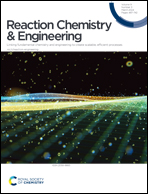A novel diamine non-aqueous absorbent based on N-methyl diethanolamine regulation for energy-efficient CO2 capture†
Abstract
Non-aqueous absorbents receive more and more attention due to their low sensible heat and evaporation latent heat. But their low CO2 desorption efficiency and high desorption reaction heat are still major limits for practical application. Herein, a novel non-aqueous diamine absorbent based on alkanolamine regulation is proposed. In the experiments, monoethanolamine (MEA) was used as the main absorbent for ensuring high CO2 absorption capacity and absorption rate, while polyethylene glycol 200 (PEG200) was used as a cosolvent to reduce evaporation latent heat. Subsequently, MEA/PEG200 non-aqueous absorbents were composed with three typical secondary/tertiary amines including N-methyldiethanolamine (MDEA), diethanolamine (DEA) and triethanolamine (TEA), respectively, and their regulation effects on CO2 capture performance were investigated systematically. The results showed that the MEA/MDEA/PEG non-aqueous system exhibited a superior CO2 desorption performance. The corresponding maximum regeneration efficiency reached up to 82.1%, which was significantly higher than the case without addition of MDEA. It still kept a high CO2 desorption efficiency (79%) after the 8th regeneration cycle. According to thermodynamic analysis, the desorption reaction heat for the MEA/MDEA/PEG non-aqueous system was only 1.40 GJ per ton CO2, which was 20% lower than the non-aqueous MEA/PEG200 absorbent. And its total regeneration energy consumption was 1.90 GJ per ton CO2, which was reduced by 48.1% compared to MEA aqueous solution. FT-IR, 13C-NMR and DFT calculations indicated that the introduction of the MDEA regulator would result in a much lower reaction energy barrier between zwitterions and MDEA compared to that between zwitterions and MEA. Besides, it would induce the formation of protonated MDEA (MDEAH+), which was much easier for MDEA regeneration.



 Please wait while we load your content...
Please wait while we load your content...